Land Invertebrates
Media
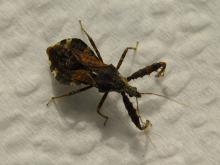
Species Types
Scientific Name
Sinea spinipes
Description
The spiny assassin bug is one of nearly 200 species of assassin bugs in North America. It walks, hops, and flies to capture its insect prey.
Media

Species Types
Scientific Name
Meloe spp.
Description
Blister beetles in the genus Meloe are called oil beetles because of a yellowish oil they excrete from their joints when squeezed or distressed. This oil contains cantharidin, an irritating chemical that can cause blistering in many people.
Media
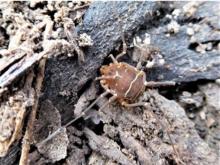
Species Types
Scientific Name
Members of suborder Laniatores
Description
Armored harvestmen have spines on their fingerlike mouthparts (pedipalps). Unlike other harvestmen, members of this suborder of so-called daddy longlegs do not usually have long legs.
Media
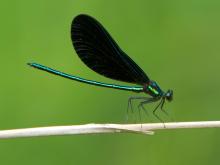
Species Types
Scientific Name
Calopteryx maculata
Description
The ebony jewelwing is a beautiful iridescent green or turquoise damselfly with large black wings. It flutters around streams in wooded areas.
Media

Species Types
Scientific Name
Libellula luctuosa
Description
The widow skimmer has distinctive dark wing markings that seem like mourning garb. Mature males have white areas in the center of their wings, beside the dark patches, while females and immature males lack the white patches.
Media
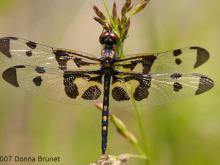
Species Types
Scientific Name
Celithemis fasciata
Description
The banded pennant is a small dragonfly (to about 1½ inch long) with distinctive black markings and reddish eyes.
Media

Species Types
Scientific Name
Dromogomphus spp.
Description
Spinyleg clubtails are dragonflies in genus Dromogomphus. There are at least three species that look very similar.
Media

Species Types
Scientific Name
Gomphurus vastus
Description
The cobra clubtail is in the family of dragonflies called clubtails, named for the enlarged abdomen tip. There are about 100 species in this dragonfly family in North America north of Mexico.
Media
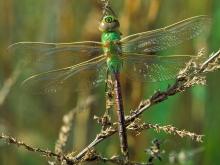
Species Types
Scientific Name
Anax junius
Description
The common green darner is abundant and well-known for its bright green, blue, and purple colors. A large dragonfly up to 3 inches long, it is a migratory species that travels south in autumn.
Media

Species Types
Scientific Name
Celithemis elisa
Description
The calico pennant is a colorful, beautifully marked dragonfly. Males have pink wing veins and females have yellow. Males have a row of bright reddish heart-shapes on the abdomen; females have yellow.
See Also



Media

Species Types
Scientific Name
Cisseps fulvicollis
Description
The yellow-collared scape moth is more often “orange-collared.” And whether you think it looks more like a firefly or a wasp, it’s still a moth!
Media

Species Types
Scientific Name
Nearly 150 species in North America north of Mexico
Description
Slim, delicate plume moths are instantly recognizable by their T-shaped silhouette, long legs, and muted shades of tan and brown. It can be hard to separate the various species.
Media

Species Types
Scientific Name
Pyrrharctia isabella
Description
Not many people know the adult Isabella tiger moth when they see one, but we’re all acquainted with its caterpillar, the woolly worm, or woolly bear.
About Land Invertebrates in Missouri
Invertebrates are animals without backbones, including earthworms, slugs, snails, and arthropods. Arthropods—invertebrates with “jointed legs” — are a group of invertebrates that includes crayfish, shrimp, millipedes, centipedes, mites, spiders, and insects. There may be as many as 10 million species of insects alive on earth today, and they probably constitute more than 90 percent all animal species.





















